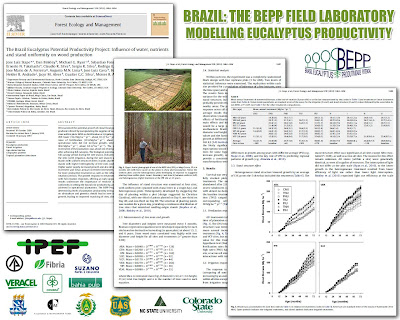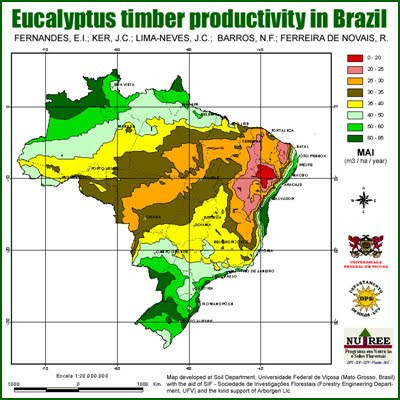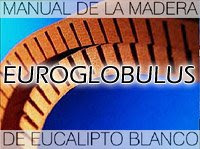Eucalyptus Ecology & Environmental Sustainability : it is about Science

Stape JL, Binkley D, Ryan MG, Fonseca S, Loos RA, Takahashi EN, Silva CR, Silva SR, Hakamada RE, Ferreira JM de A, Lima AMN, Gava JL, Leite FP, Andrade HB, Alves JM, Silva GGC, Azevedo MR. (2010) The Brazil Eucalyptus Potential Productivity Project: Influence of water, nutrients and stand uniformity on wood production. Forest Ecology and Management 259: 1684-1694. (Click image to enlarge)

Fig. 1: BEPP (Brazilian Eucalyptus Potential Productivity) Field Forestry Laboratory: Different clonal Eucalyptus tree stocking areas are subject to variations of availability of light, water and nutrients to simulate different silvicultural practices, different cultivation areas along Brazil and different genotypes for Eucalyptus tree crops.

Fig. 2: Brazilian BEPP Eucalyptus Field Laboratory: Different experimental designs are applied to the range of tree stocking plots in order to gain insight and be able to predict how and in which amounts do clonal Eucalyptus plantations use the available building materials (light, water, nutrients) to produce woody biomass in fast growing timber crops.

Fig. 3: Brazilian BEPP Eucalyptus Field Laboratory: Modelling water and nutrient cycles in clonal Eucalyptus plantations is achieved by monitoring soil status before, along and after the cultivation cycle, plus designing and building on site water collection infrastructures. Water cycle balances can hence be studied, and variations depending on rainfall, canopy interception, trunk percolation, soil absorption and excess runoff can be measured and modelized. This can later be linked to different silvicultural practices, to predict the impacts of clonal Eucalyptus plantations and to refine cultivation techniques to achieve as sustainable production as possible.

Fig. 4: Brazilian BEPP Eucalyptus Field Laboratory: Modelling water and nutrient cycles and predicting growth rates in clonal Eucalyptus plantations. Different rainfall patterns or soil water availability ranges are simulated by artificial irrigation, allowing to expand the models, predictions and estimations to different cultivation areas of Brazil, different seasonal types, different soil types, different topographic conditions for clonal Eucalyptus timber crops.

Fig. 5: Brazilian BEPP Eucalyptus Field Laboratory: FIBRIA's (Aracruz + Votorantim) staff installing water use monitoring sensors. Target: modelling Eucalyptus water use efficiency and its impact on growth rates. Individual tree water use studies are conducted by monitoring how, when and how much water (or "nutrient soup" if you preffer) is used by the trees to produce biomass.

Fig. 6: Brazilian BEPP Eucalyptus Field Laboratory: Modelling Eucalyptus water use efficiency and its impact on growth rates. Subject to the range of variation in genotypes, tree stocking and water inputs, empirical monitoring of water use can allow an estimation of both growth rates for varied environments suitable for timber crops and of water consumption and impacts on water availability at catchment level.

Fig. 7: Brazilian BEPP Eucalyptus Field Laboratory: Modelling the carbon capture process in clonal Eucalyptus plantations. Eucalyptus timber crops convert solar energy, available water and soil mineral nutrients into organic, renewable, recyclable and carbon rich biomass. Part of that biomass becomes fiber or wood based products, thus temporary CO2 sinks of diverse lifetimes at once they are the basement for industrial timber production. Another part of that biomass becomes a permanent stock of stored CO2 in sustainably managed plantations. Yet another part of that biomass decays naturally along time and emits carbon, but at once returns mineral nutrients to the soil cycles, diminishing the need of external inputs of other fertiliser with a more noticeable carbon footprint. The emitted plus an impressive extra amount of CO2 is captured again by the trees to build biomass in continuous cycles making clonal Eucalyptus plantations become air purifiers and net carbon stockers, hence contributing twice to the fight against climate change.

Fig. 8: During the last 15 years, a joint research consortium of 5 universities (University of Sao Paulo – ESALQ, Universidade Federal da Bahía, Universidade Federal do Río Grande do Norte, Colorado State University and North Carolina State University), 8 Brazilian forestry corporations (Aracruz Celulose, Cenibra, Copener Florestal, International Paper do Brasil, Suzano Bahia Sul Celulose, Votorantim Celulose e Papel, Veracel Celulose and V & M Florestal) plus 4 governmental forestry research agencies (the Brazilian Institute for Forestry Studies & Research - IPEF, the Rocky Mountain Research Station of the USDA Forest Service; the Brazilian National Council for Scientific & Technological Development - CNPq; and the French Centre for International Cooperation in Agronomic Research & Development / CIRAD - France) has become one of the most impressive and world leading technical and scientific teams for fast growing plantation timber ecology modelling, and has produced an inmense wealth scientific data and evidence supporting decission making for an increasingly sustainable management of eucalypt cultivated forests. At once, thanks to them and many others in many countries, Eucalyptus timber plantations have become one of the best scientifically studied and monitored options for both timber production and carbon storage, supplying all concerned individuals with sound information able to unmask the propagation of Eucalyptus myths. Brazil: Ordem, e Progresso.
Want to know more? Recent Eucalyptus science!
Dan Binkley, Jean-Paul Laclau, Jose Luiz Stape & Michael G. Ryan (2010) Applying ecological insights to increase productivity in tropical plantations. Forest Ecology and Management, Volume 259, Issue 9, Productivity in Tropical Plantations, Pages 1681-1683, ISSN 0378-1127, DOI:10.1016/j.foreco.2010.01.023
Michael G. Ryan, Jose Luiz Stape, Dan Binkley, Sebastiao Fonseca, Rodolfo A. Loos, Ernesto N. Takahashi, Claudio R. Silva, Sergio R. Silva, Rodrigo E. Hakamada, Jose Mario Ferreira, Augusto M.N. Lima, Jose Luiz Gava, Fernando P. Leite, Helder B. Andrade, Jacyr M. Alves, Gualter G.C. Silva (2010) Factors controlling Eucalyptus productivity: How water availability and stand structure alter production and carbon allocation. Forest Ecology and Management, Volume 259, Issue 9, Productivity in Tropical Plantations, Pages 1695-1703, ISSN 0378-1127, DOI:10.1016/j.foreco.2010.01.013
Dan Binkley, Jose Luiz Stape, William L. Bauerle, Michael G. Ryan (2010) Explaining growth of individual trees: Light interception and efficiency of light use by Eucalyptus at four sites in Brazil. Forest Ecology and Management, Volume 259, Issue 9, Productivity in Tropical Plantations, Pages 1704-1713, ISSN 0378-1127, DOI:10.1016/j.foreco.2009.05.037
Robert M. Hubbard, Jose Stape, Michael G. Ryan, Auro C. Almeida, Juan Rojas (2010) Effects of irrigation on water use and water use efficiency in two fast growing Eucalyptus plantations. Forest Ecology and Management, Volume 259, Issue 9, Productivity in Tropical Plantations, Pages 1714-1721, ISSN 0378-1127, DOI: 10.1016/j.foreco.2009.10.028
Auro C. Almeida, Anders Siggins, Thiago R. Batista, Chris Beadle, Sebastiao Fonseca, Rodolfo Loos (2010) Mapping the effect of spatial and temporal variation in climate and soils on Eucalyptus plantation production with 3-PG, a process-based growth model. Forest Ecology and Management, Volume 259, Issue 9, Productivity in Tropical Plantations, Pages 1730-1740, ISSN 0378-1127, DOI: 10.1016/j.foreco.2009.10.008
Celso E. B. Foelkel & Ester Foelkel (2008) The Friends of the Eucalyptus: Dr. José Luiz Stape. Eucalyptus Newsletter nº 14. Grau Celsius' Eucalyptus Online Book & Newsletter. www.eucalyptus.com.br
Also here in EUCALYPTOLOGICS...






Want to contact us?

Contact GIT Forestry Consulting - Eucalyptologics

GIT's Eucalyptology Topics
© 2007-2010 Gustavo Iglesias Trabado. Please contact us if you want to use all or part of this text and photography elsewhere. We like to share, but we do not like rudeness.



























0 Comments by our readers :::
Send a comment to EUCALYPTOLOGICS